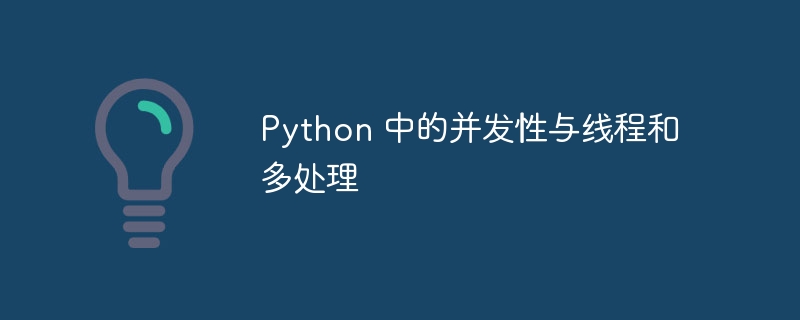Python 中的并发性与线程和多处理
来源:dev.to
时间:2024-09-14 09:45:59 273浏览 收藏
IT行业相对于一般传统行业,发展更新速度更快,一旦停止了学习,很快就会被行业所淘汰。所以我们需要踏踏实实的不断学习,精进自己的技术,尤其是初学者。今天golang学习网给大家整理了《Python 中的并发性与线程和多处理》,聊聊,我们一起来看看吧!

并发是现代编程中的一个重要思想,它允许多个任务同时运行以提高应用程序的性能。
在 python 中实现并发的方法有多种,其中最著名的是线程和多处理。
在本文中,我们将详细探讨这两种方法,了解它们的工作原理,并讨论何时使用每种方法,以及实际的代码示例。
什么是并发?
在我们讨论线程和多处理之前,了解并发的含义很重要。
并发是指一个程序可以同时执行多个任务或进程。
这可以使程序更好地利用资源并运行得更快,特别是当它需要执行诸如读取文件或进行大量计算之类的操作时。
实现并发的方式主要有两种:
- 并行性:在计算机处理器的不同部分上同时运行多个任务。
- 并发:在同一时间段内处理多个任务,但不一定在完全相同的时刻。
python 提供了两种主要方式来实现并发:
- 线程:适用于可以同时管理的任务。
- 多处理:适用于需要在不同处理器核心上真正同时运行的任务。
python 中的线程
线程允许您在同一进程内运行多个较小的进程单元(称为线程),共享相同的内存空间。
线程比进程更轻,并且它们之间的切换更快。
但是,python 中的线程受全局解释器锁 (gil) 的约束,这确保一次只有一个线程可以执行 python 代码。
线程如何工作
python的线程模块提供了一种简单灵活的方式来创建和管理线程。
让我们从一个基本示例开始:
import threading
import time
def print_numbers():
for i in range(5):
print(f"number: {i}")
time.sleep(1)
# creating a thread
thread = threading.thread(target=print_numbers)
# starting the thread
thread.start()
# wait for the thread to complete
thread.join()
print("thread has finished executing")
# output:
# number: 0
# number: 1
# number: 2
# number: 3
# number: 4
# thread has finished executing
在此示例中:
- 我们定义了一个函数 print_numbers(),它打印从 0 到 4 的数字,两次打印之间有一秒的延迟。
- 我们使用 threading.thread() 创建一个线程,并将 print_numbers() 作为目标函数传递。
- start() 方法开始线程的执行,而 join() 确保主程序等待线程完成后再继续执行。
示例:i/o 密集型任务的线程化
线程对于 i/o 密集型任务特别有用,例如文件操作、网络请求或数据库查询,在这些任务中程序大部分时间都在等待外部资源。
这是一个使用线程模拟下载文件的示例:
import threading
import time
def download_file(file_name):
print(f"starting download of {file_name}...")
time.sleep(2) # simulate download time
print(f"finished downloading {file_name}")
files = ["file1.zip", "file2.zip", "file3.zip"]
threads = []
# create and start threads
for file in files:
thread = threading.thread(target=download_file, args=(file,))
thread.start()
threads.append(thread)
# ensure all threads have finished
for thread in threads:
thread.join()
print("all files have been downloaded.")
# output:
# starting download of file1.zip...
# starting download of file2.zip...
# starting download of file3.zip...
# finished downloading file1.zip
# finished downloading file2.zip
# finished downloading file3.zip
# all files have been downloaded.
通过为每个文件下载创建和管理单独的线程,程序可以同时处理多个任务,从而提高整体效率。
代码中关键步骤如下:
- 定义了一个函数 download_file 来模拟下载过程。
- 创建文件名列表来表示需要下载的文件。
- 对于列表中的每个文件,都会创建一个新线程,并以 download_file 作为其目标函数。每个线程在创建后立即启动并添加到线程列表中。
- 主程序使用 join() 方法等待所有线程完成,确保程序在所有下载完成之前不会继续进行。
线程的局限性
虽然线程可以提高 i/o 密集型任务的性能,但它也有局限性:
- 全局解释器锁 (gil):对于 cpu 密集型任务,gil 限制一次只能执行一个线程,从而限制了多核处理器中线程的有效性。
- 竞争条件:由于线程共享相同的内存空间,不正确的同步可能会导致竞争条件,程序的结果取决于线程的时间。
- 死锁:线程相互等待释放资源可能会导致死锁,从而无法取得任何进展。
python 中的多处理
多处理通过使用单独的进程而不是线程来解决线程的局限性。
每个进程都有自己的内存空间和python解释器,允许在多核系统上实现真正的并行。
这使得多重处理成为需要大量计算的任务的理想选择。
多重处理的工作原理
python 中的多处理模块允许您轻松创建和管理进程。
让我们从一个基本示例开始:
import multiprocessing
import time
def print_numbers():
for i in range(5):
print(f"number: {i}")
time.sleep(1)
if __name__ == "__main__":
# creating a process
process = multiprocessing.process(target=print_numbers)
# starting the process
process.start()
# wait for the process to complete
process.join()
print("process has finished executing")
# output:
# number: 0
# number: 1
# number: 2
# number: 3
# number: 4
# process has finished executing
此示例与线程示例类似,但具有进程。
请注意,进程的创建和管理与线程类似,但由于进程运行在单独的内存空间中,因此它们是真正并发的,并且可以运行在不同的 cpu 核心上。
示例:cpu 密集型任务的多处理
多处理对于受 cpu 限制的任务特别有用,例如数值计算或数据处理。
这是一个使用多个进程计算数字平方的示例:
import multiprocessing
def compute_square(number):
return number * number
if __name__ == "__main__":
numbers = [1, 2, 3, 4, 5]
# create a pool of processes
with multiprocessing.pool() as pool:
# map function to numbers using multiple processes
results = pool.map(compute_square, numbers)
print("squares:", results)
# output:
# squares: [1, 4, 9, 16, 25]
以下是代码中的关键步骤:
- 函数compute_square被定义为接受一个数字作为输入并返回其平方。
- if name == "main": 块中的代码确保它仅在直接执行脚本时运行。
- 定义了一个数字列表,将对其进行平方。
- 工作进程池是使用 multiprocessing.pool() 创建的。
- map 方法用于将compute_square函数应用于列表中的每个数字,将工作负载分配到多个进程。
进程间通信(ipc)
由于每个进程都有自己的内存空间,进程之间共享数据需要进程间通信(ipc)机制。
多处理模块提供了一些用于ipc的工具,例如queue、pipe和value。
这是一个使用队列在进程之间共享数据的示例:
import multiprocessing
def worker(queue):
# Retrieve and process data from the queue
while not queue.empty():
item = queue.get()
print(f"Processing {item}")
if __name__ == "__main__":
queue = multiprocessing.Queue()
# Add items to the queue
for i in range(10):
queue.put(i)
# Create a pool of processes to process the queue
processes = []
for _ in range(4):
process = multiprocessing.Process(target=worker, args=(queue,))
processes.append(process)
process.start()
# Wait for all processes to complete
for process in processes:
process.join()
print("All processes have finished.")
# Output:
# Processing 0
# Processing 1
# Processing 2
# Processing 3
# Processing 4
# Processing 5
# Processing 6
# Processing 7
# Processing 8
# Processing 9
# All processes have finished.
在此示例中:
- defworker(queue):定义一个以队列作为参数的函数worker。该函数检索并处理队列中的项目,直到队列为空。
- if name == "main":: 确保以下代码仅在直接执行脚本时运行,而不是作为模块导入时运行。
- queue = multiprocessing.queue():创建用于进程间通信的队列对象。
- for i in range(10):queue.put(i):将项目(数字 0 到 9)添加到队列中。
- processes = []:初始化一个空列表来存储进程对象。
- for _ in range(4) 循环:创建四个工作进程。
- process = multiprocessing.process(target=worker, args=(queue,)):创建一个以worker为目标函数的新进程,并将队列作为参数传递。
- processes.append(process):将进程对象添加到进程列表中。
- process.start():启动进程。
- 进程中进程的 for 循环:使用 join() 方法等待每个进程完成。
多重处理的挑战
虽然多处理提供了真正的并行性,但它也面临着一系列挑战:
- 更高的开销:由于内存空间是独立的,创建和管理进程比线程更耗费资源。
- 复杂性:进程之间的通信和同步比线程更复杂,需要ipc机制。
- 内存使用:每个进程都有自己的内存空间,导致与线程相比内存占用更高。
何时使用线程与多处理
在线程和多处理之间进行选择取决于您正在处理的任务类型:
使用线程:
- 对于需要大量等待的任务,例如网络操作或读/写文件(i/o 密集型任务)。
- 当您需要在任务之间共享内存并可以管理竞争条件等潜在问题时。
- 实现轻量级并发,无需创建多个进程的额外开销。
使用多重处理:
- 对于需要大量计算或数据处理的任务(cpu 密集型任务),并且可以从同时在多个 cpu 核心上运行中受益。
- 当您需要真正的并行性并且线程中的全局解释器锁(gil)成为限制时。
- 适用于可以独立运行且不需要频繁通信或共享内存的任务。
结论
python 中的并发是让应用程序运行得更快的强大方法。
线程非常适合需要大量等待的任务,例如网络操作或读/写文件,但由于全局解释器锁(gil)的原因,它对于需要大量计算的任务并不那么有效。
另一方面,多处理允许真正的并行性,使其非常适合 cpu 密集型任务,尽管它会带来更高的开销和复杂性。
无论您是处理数据、处理多个网络请求,还是进行复杂的计算,python 的线程和多重处理工具都能为您提供所需的功能,使您的程序尽可能高效、快速。
文中关于的知识介绍,希望对你的学习有所帮助!若是受益匪浅,那就动动鼠标收藏这篇《Python 中的并发性与线程和多处理》文章吧,也可关注golang学习网公众号了解相关技术文章。
-
501 收藏
-
501 收藏
-
501 收藏
-
501 收藏
-
501 收藏
-
139 收藏
-
247 收藏
-
405 收藏
-
467 收藏
-
181 收藏
-
499 收藏
-
480 收藏
-
419 收藏
-
441 收藏
-
275 收藏
-
224 收藏
-
458 收藏
-

- 前端进阶之JavaScript设计模式
- 设计模式是开发人员在软件开发过程中面临一般问题时的解决方案,代表了最佳的实践。本课程的主打内容包括JS常见设计模式以及具体应用场景,打造一站式知识长龙服务,适合有JS基础的同学学习。
- 立即学习 543次学习
-

- GO语言核心编程课程
- 本课程采用真实案例,全面具体可落地,从理论到实践,一步一步将GO核心编程技术、编程思想、底层实现融会贯通,使学习者贴近时代脉搏,做IT互联网时代的弄潮儿。
- 立即学习 516次学习
-

- 简单聊聊mysql8与网络通信
- 如有问题加微信:Le-studyg;在课程中,我们将首先介绍MySQL8的新特性,包括性能优化、安全增强、新数据类型等,帮助学生快速熟悉MySQL8的最新功能。接着,我们将深入解析MySQL的网络通信机制,包括协议、连接管理、数据传输等,让
- 立即学习 500次学习
-

- JavaScript正则表达式基础与实战
- 在任何一门编程语言中,正则表达式,都是一项重要的知识,它提供了高效的字符串匹配与捕获机制,可以极大的简化程序设计。
- 立即学习 487次学习
-

- 从零制作响应式网站—Grid布局
- 本系列教程将展示从零制作一个假想的网络科技公司官网,分为导航,轮播,关于我们,成功案例,服务流程,团队介绍,数据部分,公司动态,底部信息等内容区块。网站整体采用CSSGrid布局,支持响应式,有流畅过渡和展现动画。
- 立即学习 485次学习
